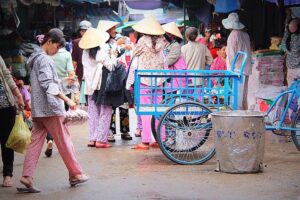Vietnam has millions of economically active women who interact with the formal financial sector at a superficial level. Women’s World Banking worked with Maritime Bank to develop a strategy to deepen its outreach the women’s market. By recognizing distinct segments within the women’s market and designing product bundles to address their unique needs, Maritime Bank can increase its market share and encourage economic activity in the country.
Vietnam is an Asian economic powerhouse, its economy growing tremendously over the past 30 years. PWC estimates that Vietnam will be one of the three fastest growing economies in the world from now until 2050, with an annual growth rate of over 5%.[i]
Compared to other lower middle-income countries, women are especially economically active in Vietnam. The female labor force participation rate is within 10 percentage points of men largely due to the influx of foreign-owned export-oriented manufacturing.[ii] With a market of 35 million women who are highly literate and digitally connected, financial service providers in Vietnam face a significant market opportunity.
But there is a gap between opportunity and reality. Almost 24 million women lack a bank account and according to the 2017 Findex[iii], only 30% of women over age 15 have a bank account. Providing these financially excluded but economically active women with financial services can unlock economic activity throughout Vietnam and benefit financial service providers, women and families, and the entire country.
With the support of the Australian Department of Foreign Affairs, Women’s World Banking began working with Maritime Bank (MSB) in 2017 to help the institution reach more women. Though women were already a strong and growing part of the bank’s client base and represented a majority of new clients, MSB wanted to understand how to better serve this segment and realize its market potential.
Women’s World Banking worked with MSB to develop a strategy to deepen its outreach to the women’s market, with a focus on retail and community banking. Women’s World Banking interviewed more than 70 consumers to identify opportunities to increase the availability of quality financial products and services to women in Vietnam.
Distinct Segments Have Distinct Financial Needs that Require Distinct Products

Women’s World Banking looked at the unique behaviors, financial needs, and opportunities of three underbanked segments of women in Vietnam: home-based business owners, market traders, and factory workers. While many had access to some formal finance, perhaps through a current account, they were not ready to go beyond that. One potential woman client said, “they have a lot of conditions and paperwork so we cannot have the support from them.” Another woman shared that “If you have less you feel ashamed to have so little to bring to the bank.”
In addition, while savings is widespread across the three segments, primarily through informal means, the research showed each segment has distinct needs that could not be addressed by a one-size-fits-all approach.
Home-based business owners include women who sell products from home, mainly online through Facebook. These women are highly digitally connected, using mobile phones to manage their businesses. They tend to be experts at juggling competing needs and are eager for knowledge to take advantage of emerging e-commerce opportunities. Their biggest challenge is time, as they juggle family and business responsibilities.
Market traders are women with well-established businesses in the market (typically between 5-15 years) with stable incomes. However, they are under pressure from emerging online-based competitors and they are eager to learn more about mobile banking to respond to this growing competition. Although they are established, they value and would benefit from access to working capital loans and knowledge to help them expand their businesses.
Factory workers have salary accounts, appreciate loans to upgrade their standard of living, and would value services that allow them to make it easier to save from their income. For this segment, tools that help them manage finances and save are most important.
A Woman-Centered Approach Unlocks Opportunity
Each market segment’s financial needs and preferences differed significantly based on their income-generating activity. Women’s World Banking and MSB realized that the institution’s product offering needed to be more targeted to each segment to make it more relevant, and thus, more appealing. Thus, Women’s World Banking and MSB decided on a strategy of bundling MSB’s existing products to meet these segments’ specific needs. Bundling simplifies the offerings to customers and enables staff to focus their efforts on better client service. For instance, a bundle for online business owners would include the current account they’re already using, but also a linked savings account, and non-financial services such as mobile banking, business skills training or networking.

This solution was only half the story. Addressing potential women clients’ disconnect is also crucial. Along with tailoring products, it is important to build a marketing strategy with messaging that speaks to women and their needs. Communicating values such as empowerment and convenience to make women feel welcome and comfortable creates an environment where women feel that they can take up the products that have been designed for them.
Through addressing and overcoming product mismatch and client misperceptions, MSB and other financial service providers can reach potentially millions of women in Vietnam.
Enabling Vietnam’s Economically Active Women to Help the Economy Grow
Targeting women is a huge opportunity to grow an institution’s client base, increase revenue and deepen financial inclusion for economically active, yet underbanked women. It can also be an entry point to serving families as a whole. Given their status within households and their economic activity, providing services with trust and care can ripple across the family and increase revenue for institutions.
Bridging the gap between the economic activity of women and their underuse of financial services can unlock opportunity and help accelerate the country’s economic growth trajectory.
[i] PwC, “The Long View: How will the global economic order change by 2050?” https://www.pwc.com/gx/en/world-2050/assets/pwc-the-world-in-2050-full-report-feb-2017.pdf
[ii] The World Bank In Vietnam, http://www.worldbank.org/en/country/vietnam/overview
[iii] World Bank. 2017 Global Findex. https://globalfindex.worldbank.org/



